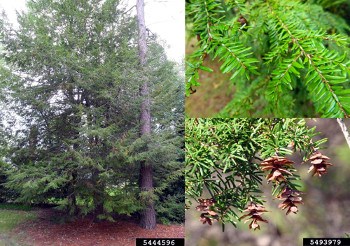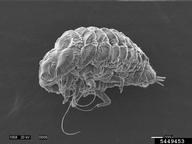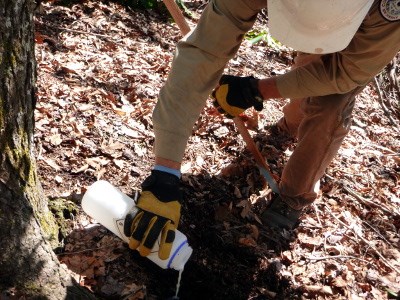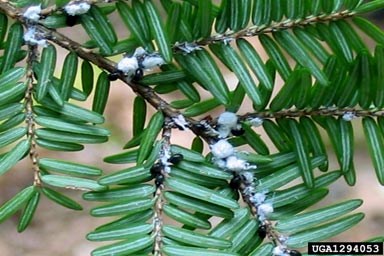
NPS Photo- Chris Ulrey Our mountain forests are changing and the evidence is visible all along the Blue Ridge Parkway. The once lush foliage of the hemlocks has given way to dead and dying trees under attack by an invasive insect. Eastern and Carolina Hemlocks provide nesting sites for birds and shade critical to the survival of many species on the forest floor and in streams.The hemlock's range and populations have ebbed and flowed over the millennium due to retreating glaciers and drought, and previous insect attacks. Another attack is underway and we are working to keep this tree alive.

Left: Forestryimages.org- David Stevens; Upper right, NPS Photo- Carol Petricevic; Lower right- Forestryimages.org- William Ciesla The Cause and Effect: The eastern hemlock (Tsuga canadensis) is a lacy needled, but stately and very tall conifer that ranges from the Southern Appalachians and north up through the mid-Atlantic and New England states, and into southeastern Canada. It is also found in the northern Great Lakes region. The hemlock is most commonly found in cool, damp coves and along creeks. It is often called the "redwood of the east." The Parkway is also home to the rare Carolina hemlock (Tsuga caroliniana) and is most common on damp rocky slopes and outcrops in in the southern Appalachians. The northernmost population of this species is found on the Parkway. 
Forestryimages.org- Kelly Oten The hemlock wooly adelgid is an insect native to Japan and was originally introduced to the eastern United States to Richmond, Virginia, in the 1950s. It is found in the mid-Atlantic states and down the Appalachians. Range expansions are occurring to the north, into New England, but is slowed by the colder northern temperatures. The adelgid has been found in the Pacific Northwest since the 1920s, but it is unknown whether it is native or introduced to the region, because there are native adelgid predators.Discovered on the Blue Ridge Parkway in 1984, the Hemlock Woolly Adelgid has devastated the trees in Southern Appalachia. Without treatment, the remaining infested trees will also be lost.

Forestryimages.org- US Forest Service, region 8 
NPS photo- Chris Ulrey What are we doing? Land managers from the National Park Service and U.S. Forest Service along with many partners have been working to reduce the impacts of the aldegids' spread by using chemical and biological controls. In the short term, many trees have been saved with application of a pesticide, imidacloprid to their roots, which the hemlock takes up to its leaves. When the insect takes in the chemical, it dies. Dinotefuron is also used, as a faster working chemical, when a tree is very close to death. Both chemicals are also used as flea treatments for cats and dogs. 
NPS photo courtesy of Great Smoky Mountains National Park Hope for tomorrow The disappearance of the hemlocks would have devastating impacts to vital habitats, water and air quality, and soil conservation. Studies have shown that the evergreen hemlock works like a blanket or shade over streams and protects native brook trout populations. Loss of hemlocks have made streams warmer in the summer and cooler in the winter, making it harder for the trout and other associated species to survive. In some places, rhododendrons have increased in density, making thickets that are impenetrable. Although the adelgid will not be eradicated, biologists believe that trees saved today will provide seeds for tomorrow's hemlock stands. With continued funding, staffing and committed partners, research and restoration efforts can be possible. |
Last updated: October 8, 2015
